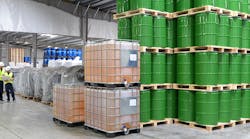This webinar was originally broadcast on February 29, 2024.
Now Available On Demand!
Already registered? Click here to log in.
Summary
The use and storage of hazardous materials in any structure can introduce facilities to several regulatory and permitting requirements. One of the most overlooked requirements is how hazardous materials utilization impacts the Building Code occupancy classification of a facility.
Model building codes in the United States establish strict requirements for hazardous materials through the occupancy classification process. These codes rely on the accurate determination of Group H Occupancy designation to ensure proper building features are provided for occupant, facility, and emergency responder safety. Building codes don’t require the classification of every hazardous material use as a high-hazard occupancy, but rather apply thresholds that divide any traditional occupancy groups from a Group H Occupancy.
This webinar will provide an overview of the model building codes used in the United States and describes a three-step process to ensure accurate classification. Case studies featuring common challenges involving modern high-technology materials will be highlighted, including the handling/use of combustible dust, modern refrigerant replacement gases, and lithium-ion batteries.
Learning Objectives:
- Describe the Role of Occupancy Classification in the Model Building & Fire Code
- Awareness of the implications of Group H (High Hazard) Occupancy Classification
- Understanding the 3-step Process Used to Accurately Classify Occupancies with Haz Mat
- Characterize the Hazardous Material(s) Planned or Used
- Determine Use Category for Each Hazardous Material
- Properly Account for the Quantity of Hazardous Material
- Awareness of New Occupancy Classification Challenges Provided for Facilities Handling Combustible Dust, Modern Environmentally Friendly Refrigerants, and Lithium-Ion Batteries
Speaker
Michael D. Snyder, P.E., CSP, CFSP, CFEI
Vice President - Operational Risk Management | DEKRA
Michael D. Snyder is the Operational Risk Management Vice President for DEKRA. He was previously the Global Director of Safety and Loss Prevention for Dow Corning Corp., responsible for leading the company’s occupational and process safety programs.
He currently serves on the Center for Chemical Process Safety (CCPS) Governing Board and is a former member of the National Fire Protection Association (NFPA) Standards Council. He is also a technical committee member on NFPA 30, "Flammable and Combustible Liquids Code," NFPA 1, "Fire Code," and NFPA 1720, "Standard for the Organization and Deployment of Fire Suppression Operations, Emergency Medical Operations and Special Operations to the Public by Volunteer Fire Departments."
Snyder earned a bachelor’s degree in chemical engineering from Cornell Univ., and a master’s degree in occupational safety and health from Columbia Southern Univ. He is a registered professional engineer in Michigan.
Sponsored by


























